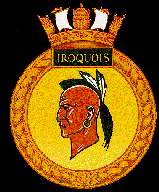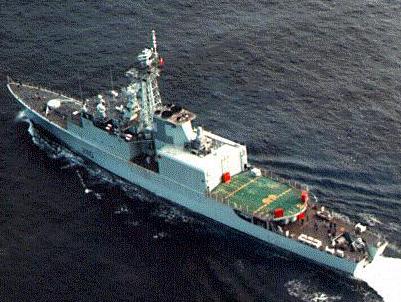HMCS IROQUOIS
DDH 280
 By
the mid 1980s, IROQUOIS was beginning to become obsolete. The once state-of-the-art
warship was rapidly being eclipsed by the advances in naval weapons technology
that had taken place since commissioning a decade-and-a-half previous.
The Tribal Class Update and Modernization Project, commonly known by its
acronym TRUMP, was initiated to rectify these deficiencies. She is the
lead ship of the class and the second one to complete the TRUMP program. By
the mid 1980s, IROQUOIS was beginning to become obsolete. The once state-of-the-art
warship was rapidly being eclipsed by the advances in naval weapons technology
that had taken place since commissioning a decade-and-a-half previous.
The Tribal Class Update and Modernization Project, commonly known by its
acronym TRUMP, was initiated to rectify these deficiencies. She is the
lead ship of the class and the second one to complete the TRUMP program.
In October 1988, IROQUOIS sailed to Lauzon, Quebec to commence what would be a three-and-a-half year refit. Under this program, the ship's role was transformed from an general purpose destroyer whose primary focus was ASW (anti-submarine warfare) into a Command and Control flagship that was capable of providing area air defence for a Canadian task group at sea. To fulfil this role, IROQUOIS was fitted with an entirely new above-water weapons, sensor and command and control suite including the U.S. Navy's Mark 41 Vertical Launch System armed with Standard SM-2 anti-air missiles - the same weapon used aboard U.S. Navy "AEGIS" class cruisers and destroyers. The SM-2 is a highly effective missile that can easily engage hostile missiles and aircraft out to ranges in excess of 55 miles. The 5 inch gun was replaced by an Oto Melara 76mm Super Rapid Gun Mount, or SRGM, which has a variable rate of fire of up to 120 rounds per minute. Both the gun and the missile system are controlled by two Separate Tracking and Illuminating Radars, called STIRS, manufactured by Signaal Apparaten of the Netherlands. The gun can also be controlled by a separate director called LIROD - the Lightweight Radar and Optronic Director. Close in air-defence is provided by a 20mm Vulcan Phalanx gattling gun mounted on top of the hangar. The air and surface search radars have been upgraded to the LW-08 and DA-08 respectively, also manufactured by Signaal. The entire system is controlled by a Canadian designed computer system, utilizing the same display consoles as the new HALIFAX class frigates. The ASW suite has also been enhanced with the recent installation of the Canadian AN/SQS-510 sonar suite to replace both hull- mounted and variable-depth sonars, greatly enhancing their range and display capabilities. The existing mark 32 ASW torpedo tubes remained, as well as the Mark 46 air and surface launched torpedoes. The obsolete mortar was removed. Marine engineering improvements included installation of an Integrated Machinery Control System, or IMCS, to manage the propulsion plant comprising the original Pratt and Whitney FT-4 main engines and the new Allison cruise engines. To reduce IROQUOIS' heat signature, an entirely new funnel system replaced the distinctive "bunny ear" funnels. A water compensated fuel system was installed, as well as an automatic fire detection and suppression system. The old evaporators for producing fresh water at sea were replaced with modern reverse osmosis desalinators. With the refit completed in May 1992, IROQUOIS entered a year long trials program to test the new systems before working-up for duty as the flagship for the Standing Naval Force Atlantic, or STANAVFORLANT, in September 1993. IROQUOIS remained with the NATO fleet until the following April. During that period STANAVFORLANT was under the command of a Canadian, Commodore G.R. Maddison, and was involved in enforcing UN sanctions off the coast of the former Yugoslavia. Since then IROQUOIS has enjoyed a busy and challenging schedule of TRUMP test and trials, a major work-up and participation in numerous national, international and NATO exercises. The ship has also conducted a number of extremely successful live SM-2 missile firings. In May 1995 IROQUOIS assumed the duty of flagship for the Commander Maritime Operations Group One - Canada's Atlantic combat fleet - remaining in that role until July 1996. By the late 1990's, IROQUOIS had sailed almost 400,000 miles, visiting over 100 different ports. These numbers will undoubtedly greatly increase as IROQUOIS serves Canada well into the twenty-first century, assuredly living up to the motto "Relentless in Chase". The ship's crew have developed a Home Page for IROQUOIS. Please refer to the Related Sites section. |
 |
|
|
 |
| HMCS Iroquois DDH 280 after the TRUMP conversion. The two outward-raked funnels have now been integrated as one, the most visible feature of the modernization. (DND Photo) |
| Iroquois 280 Photo Album |